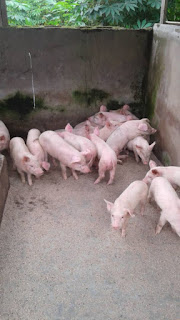Pigs are amenable to many different styles of farming. Intensive commercial units, commercial free range enterprises, extensive farming - being allowed to wander around a village, town or city, or tethered in a simple shelter or kept in a pen outside the owners house. Historically pigs were kept in small numbers and were closely associated with the residence of the owner, or in the same village or town.[1] They were valued as a source of meat, fat and for the ability to turn inedible food into meat, and often fed household food waste if kept on a homestead. Pigs have been farmed to dispose of municipal garbage on a large scale.[2]
All these forms of pig farm are in use today. In developed nations, commercial farms house thousands of pigs in climate-controlled buildings.[3]Pigs are a popular form of livestock, with more than one billion pigs butchered each year worldwide, 100 million of them in the USA. The majority of pigs are used for human food but also supply skin, fat and other materials for use as clothing, ingredients for processed foods,[4]cosmetics[5] and other and medical use.[6]
The activities on a pig farm depend on the husbandry style of the farmer, and range from very little intervention (as when pigs are allowed to roam villages or towns and dispose of garbage) to intensive systems where the pigs are contained in a building for the majority of their lives. Each pig farm will tend to adapt to the local conditions and food supplies and fit their practices to their specific situation.
The following factors can influence the type of pig farms in any given region:
- Available food supply suitable for pigs
- The ability to deal with manure or other outputs from the pig operation
- Local beliefs or traditions, including religion
- The breed or type of pig available to the farm
- Local diseases or conditions that affect pig growth or fecundity
- Local requirements, including government zoning and/or land use laws
- Local and global market conditions and demand
- Traditional farming styles and methods are uused

Comments